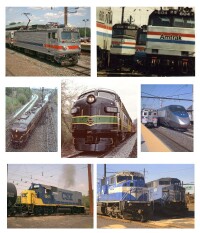| Home | Chapter History | National Info | Chapter Info | CINDERS Newsletter | Our FP7A | Transportation Links | Railfan Links |
 |
The Philadelphia Chapter of the National Railway Historical Society Established in 1936
|
|||||||
Railfan Pictures of the Week - 01/01/2006
| SEPTA Lansdale Yard Lansdale PA January 1 2006 |
|
The term "pilot" is used to describe the business end (that is, the area ahead of the wheels and below the frame, aka the point of impact at most grade crossing accidents) of a railroad locomotive or passenger cars used in either push-pull or multiple unit operation. What was found there usually depended on the railroad. Railroads in the north would have a snow plow on the front of their diesel engines (and frequently the back as well), while those in the south saw no need and many had just a flat slab of steel. Push-pull passenger cars and electric or diesel MU's often have much less, maybe a crossmember made out of angle iron or tubular steel. Of course, in the early days of railroading when trains traveled a more bucolic landscape, wild animals or livestock would often wander onto the tracks, and out of necessity, the cowcatcher was born. Recognized as the large metal wedge-shaped grate found on the front of old time steam engines we have seen in old western movies, it did not really catch cows, or anything else for that matter. Rather, it was designed to deflect objects that were in the way, pushing them off to the side and preventing them from going under the wheels and possibly derailing the train. Cowcatchers went the way of the steam engine for the most part, but their relatives are still around and can be found in interesting places. The Reading Company was a very conservative company, and its fortunes were heavily based on anthracite coal. When it came to their choice for locomotive design, they knew what buttered their bread, and held onto their steam engines well after just about everyone else had moved on to diesels. Their electrified commuter services around Philadelphia had been running since the 1930's, and that equipment shared much the same conservative mindset when it came to design. So it should be no surprise that when they turned to the Budd Company for new electric passenger cars, somehow a cowcatcher found its way into the specifications. Built for the Reading Company in 1963 by Budd at their Red Lion Plant, Class REB-13 #9009 was one of 17 Silverliner II's purchased for the railroad's commuter operations by the City of Philadelphia through the Passenger Service Improvement Corporation (PSIC). |
 |
| Just in front of the lead wheels on either end of the car, the "cowcatcher" can be found. |
 |
| As part of the same order, the Passenger Service Improvement Corporation also purchased 38 Silverliner II's for the Pennsylvania Railroad, so PRR Class MP85 # 262 and 9009 are brothers. |
 |
| However, the Pennsy saw no need for the extra protection, and its cars came sans "cowcatcher". |
 |
| When SEPTA and the City of Philadelphia upgraded the fleet in the mid 1970's, they went to GE for Silverliner IV's for both the Reading and now Penn Central. The cars were almost identical in all respects except for the Reading diamond and the PC worms decals found on the ends and ... |
 |
| of course the Reading versions, like Silverliner IV #131, got their "cowcatchers". However, being one half of a married pair, #131 has only one "cowcatcher" on the cab end of the power car, with the other on the cab end of the trailing car. |
 |
|
|
|
All pictures January 1 2006 Copyright © 2006 John P. Almeida Photographs for personal use only. All rights reserved by original owner of image. Reproduction or redistribution in any form without express written permission is prohibited. |
| Click here for previous RPOTW |
Direct website questions or comments to phillynrhs webmaster
Website created June 12, 2002
Last Updated January 1, 2006